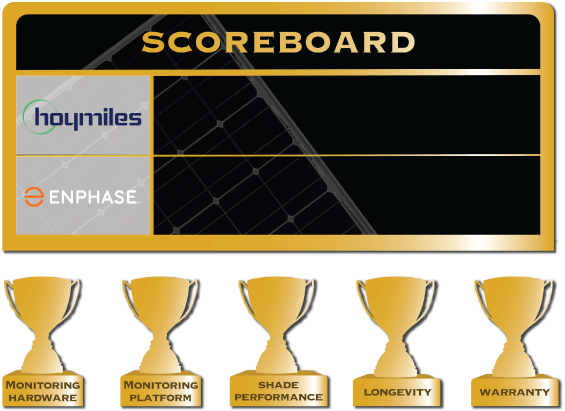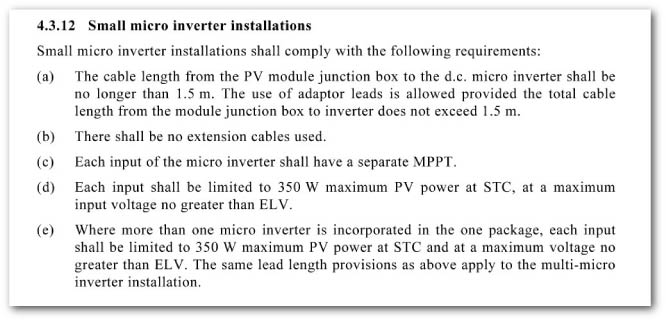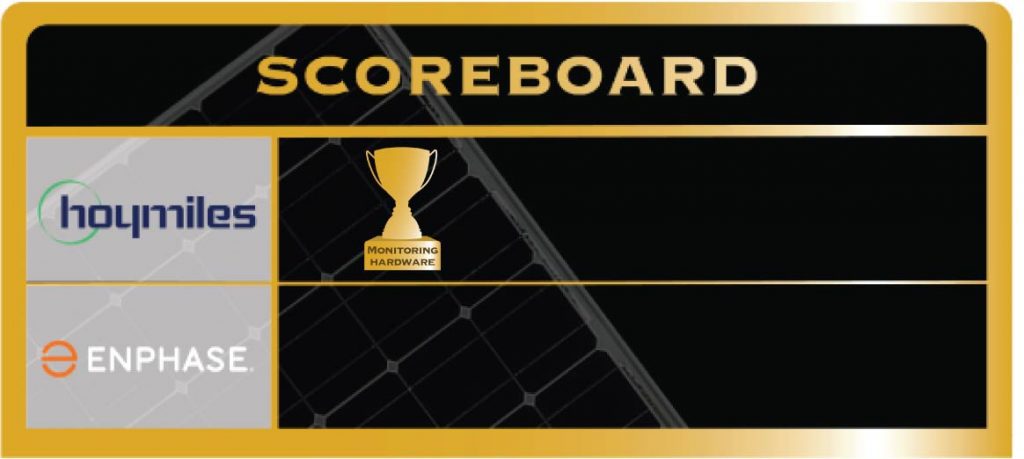
Hoymiles Microinverters are the new kid on the block, and they want to take market share from the incumbent microinverter, Enphase.
As a Chinese microinverter manufacturer, you won’t be surprised that Hoymiles main aim is to be affordable. But is the new cheap Hoymiles microinverter as good as Enphase?
In this post, I compare the two. I start out by comparing the monitoring hardware and the monitoring websites. Next, I’ll explain how Hoymiles can be so cheap. But I’ll go on to explain that the cheap “4 for 1 microinverter” has both compliance and installation hurdles. I’ll then share my side-by-side test results and explain why I’m concerned mostly about the high operating temperature of Hoymiles. Finally, we’ll compare warranties of the two microinverter companies.

Why Microinverters?

Now, let me be clear from the outset. I’m not the biggest fan of microinverters.
They have their place, and we do use them when required. However, I believe “their place” is becoming more & more niche as string inverters continue to get better.
Microinverters are not necessarily the best shade solution – as I explain in my Enphase microinverter blog. Besides, with most solar panels, you can void your warranty if the panels are ever shaded. Check out this solar panel warranty blog for that story.
Furthermore, while it is true that Micros are safer than an old-school string inverter, it would be a stretch to call them safer than a modern string inverter with fully functioning Arc Fault Circuit Interruption. But that’s an argument for another blog. For me, microinverters just unnecessarily introduce more parts, and more parts equal more future failure points. The remaining argument about panel level monitoring just doesn’t cut it for me either. Why put complicated and less reliable technology on a roof to monitor a simple, reliable, quality solar panel.
However, despite all of the downsides to microinverters, there are still some situations where microinverters are necessary.

For example, if you have ridiculously heavy shade, or you have such a small and complicated roof that just a few panels can be installed in one orientation. But which microinverter is better? The new kid on the block, Hoymiles, or the industry-leading Enphase microinverter?
Why Hoymiles?
So who is this new kid on the block, and why have they made such a stir in the Australian solar market? While Hoymiles is new to Australia, they are no slouch of a company. The Chinese microinverter company that started less than 10 years ago now has over 500 employees, including over 60 engineers in R&D. They have had huge growth in the USA, where nonsense regulations favour the use of rooftop power electronics. And now, they figure, it’s time to make waves Down Under. But how are they going to break into a competitive Aussie market?
Pricepoint.
With Hoymiles most popular offering, a 6.6kW worth of microinverters is about $1500 cheaper than Enphase! That makes it appear interesting. Can we now get the flexibility of a microinverter for the price of a string inverter?
Hoymiles have achieved this ridiculously low price through the use of “4 for 1” micros. A “4 for 1” microinverter is one inverter, with four maximum power point trackers. So you can connect four solar panels to one rooftop inverter. Because the inverter has four MPPT’s, every panel will still operate independently of the others, and each panel will have individual panel monitoring.


So, in this situation, instead of having 20 inverters on the roof, you have 5 inverters on the roof. But the 5 inverters have 4 trackers each, which means each panel still works independently. So in theory, design flexibility is as good as Enphase, except with far fewer components, or at least, far fewer microinverters.
But, there is a catch. Let’s look at the practicalities and legalities of using a 4 for 1 microinverter.
Hoymiles Compliance Issues
Well for a start, under the rule book that has been used throughout 2021 you can’t practically legally use them in Australia. Mainly because you cannot use extension cables. Check AS 5033 clause 4.3.12(b).
So, if you installed Hoymiles “4 for 1” microinverters in Australia before November 2021, it’s probably not a compliant installation. Sorry bout the bad news.

There is some good news for Hoymiles though, the new version of the Australian standards for solar installations is due in November or December 2021. By the time you are reading this, you can probably use a “4 for 1” micro, legally in Australia. But even when regulations are sorted out, there are still a couple of practical problems.
Hoymiles Installation Difficulties
Installing solar panels isn’t as simple as screwing panels to a roof. A lot of cable management goes on underneath the panel. This can be done safely and meticulously, as we do at MC Electrical, or it can be done like a dog’s breakfast, like the type of install you’ll get when you buy solar from an ex-cricketer for $3999.

To correctly loom cables from a 4 for 1 microinverter to its 4 panels, you’ll need to use at least four extension cables, all of which will be a different length. The extension cables are needed because solar panels don’t come with enough excess cable to reach to the micro. The price of these cables are approximately $12 each. Then you have to fasten all of these excess cables with stainless steel cable ties. It makes for a longer and messier install as you can see below.

You might be thinking, there is no need for cables 1 and 3. But to correctly loom to the rail and panel frame, and to prevent them from sagging and touching the roof in the future, a quality installer would most likely use these extension cables.

But the problems and extra costs don’t stop there for Hoymiles and their 4 for 1 microinverter. Remember how I said Micros are often good for smaller and more complicated roofs? If you have a small or complicated roof with anything other than groups of 4 panels, then you won’t be able to use just “4 for 1” micros. Instead, you’ll need “2 for 1” or traditional “1 for 1” micros. Hoymiles smaller microinverters are not much cheaper than Enphase. Realistically as a customer, you’re unlikely to get those $1500 Savings on a 6kW system stated up the top.
It’s also worth noting, that in some layout scenarios that despite having groups of 4 panels on a single face, you may not be able to use 4 for 1 microinverters. This is because, according the the new AS5033 standards, the microinverter can’t be mounted more than 1.5m from the panel it’s connected to. An example of this might be when you need to space panels due to an obstruction like a whirlybird, chimney, skylight or vent pipe.
But for the sake of the argument, we’ll continue assuming you have a dream roof and groups of 4 solar panels work in your favour. Maybe you can still save bucketloads compared to Enphase.
Hoymiles v Enphase Monitoring Hardware
The Hoymiles monitoring hardware solution is easier to install and, again, it’s much cheaper than Enphase.

All we need to do is plug a little Data Transfer UNIT into a powerpoint, inside and preferably near your switchboard. You’ll also want to get your sparkie to install a Hoymiles consumption meter at the switchboard and hardwire that to your DTU.
Compare that to Enphase. Enphase requires this huge and expensive box with communications and a relay to disconnect the microinverters in case of a fault. You’ll need to be a sparky to install this, and if it fails, you’ll need a sparky to repair it. If any part fails outside of the 5-year warranty, it’s not particularly cheap to fix.
As a side note, if you don’t keep your Enphase continuously connected to the internet, you’ll void your warranty on your microinverter. Seriously. Check out their terms and conditions. At least Hoymiles doesn’t have that get-out-of-jail free clause written into their terms and conditions.


So, for monitoring hardware, for multiple reasons I’m saying Hoymiles wins on cost and simplicity.
First point to Hoymiles.
Hoymiles v Enphase Monitoring Platform
Now let’s talk about the online monitoring platform. I’ve been using Enphase monitoring on and off for nearly 10 years. I do generally like Enphase as a product – and you’d think I’d like their monitoring platform because it’s familiar. But I don’t like the Enphase monitoring platform at all. I think the installer login is clunky and while the customer portal is more user-friendly, it restricts details like voltages and current readings. Also, Enphase’s installer and customer portals are missing a vital piece of information – instantaneous power production. So with Enphase, you can’t look down on your app and see how much your entire system is producing right now.

Hoymiles monitoring is different. As soon as you look at it, it just makes sense. The customer can see the same level of detail as the installer, and you can see what your solar system is producing right now. A pretty simple feature I would have thought.
So Hoymiles wins on the monitoring platform as well. That’s two for two.
So the Hoymiles monitoring is good, but let’s look at how their Microinverter performs next to Enphase.

Hoymiles v Enphase with no shade
First, how does Hoymiles compare to Enphase when there is no shade.

I actually only did a month or so of testing, but the guys down at Solar Technology and Electrical in Newcastle have been doing a comparison test for about 6 months. Our findings were very similar.
Hoymiles seems to work a little bit better than Enphase early in the morning and on cooler days. Enphase, however, seemed to work better in the middle hours or the day, and in higher temperatures. In reality, the difference wasn’t huge, but the fact that Hoymiles didn’t like the hot days rang alarm bells which I’ll go into more detail about soon.
Now let’s shade the panels. If you haven’t seen my Youtube videos, I explain, that contrary to popular belief, and contrary to microinverter marketing propaganda, microinverters do not necessarily produce better than string inverters in light to medium shade. That’s a big claim, but I’ve made a few videos explaining in depth that microinverters are not the shade solution we all thought they were.
But, the unique advantage of microinverters is heavy shade. So how does Homilies compare to Enphase in the significant shade? For the first test, I shaded a quarter of a split cell solar panel, across all the cell strings from the top, Hoymiles chose to only use the unshaded half. Enphase found a better Maximum power point and used the current from three-quarters of the panel.

After that, we fully shaded one cell string, Enphase utilised the panel bypass diode, which prevented the whole panel from being dragged down. Hoymiles never engaged the diode, so the panel was dragged down significantly by the shaded portion.

So, what’s going on here? Well, Enphase just has a superior maximum power point Algorithm. Let’s just say they have a better on-board computer that makes decisions on how to deal with shade.

All those years and all that money pumped into Enpahse R&D in Silicone valley has paid off.
So Enphase wins on shade performance. Score 1 for Enphase.
Hoymiles Microinverters Run Hot
Ok moving on, let’s talk about operating temperature. If you know a little about electronics, then you’ll know they work better and last longer when they run cooler. With a Hoymiles 4 for 1, because we are jamming a full 1300w of power through one relatively small Hoymiles microinverter, it runs damn hot. In fact, according to their own internal temperature recordings, Hoymiles got up to 77 degrees internally.

That’s a real concern considering I wasn’t running the micro in harsh conditions. It was only a 1 to 1 power ratio, on tilt frames, on a 25-degree spring day. If that little black box lasts past its warranty period, I’ll be mighty impressed. For more on what a “power ratio” is, see my oversizing blog here.
Now compare that to the Enphase microinverter which continually ran at least 10 degrees cooler. So the rule of thumb in Electronics, aka “Arrhenius’s Equation” would say that the Enphase microinverter will last twice as long.

So for longevity due to temperature, Enphase will take that point.
Now let’s see what their warranties documents say about that.
Enphase v Hoymiles warranty
Excluding any extensions, Hoymiles has a 12-year warranty on the micros and Enphase has a 10-year warranty. Realistically, same same.

For the communication boxes, Enphase has a 5-year warranty on the Envoy, and Hoymiles has a 3-year warranty on the DTU. Honestly, that’s pretty crap from both Enphase and Hoymiles because if the monitoring fails in 3 or 5 years, you’ll have to replace it in order to know if your microinverters fail.
And remember, as I mentioned earlier, Enphase’s warranty document says that if your micros are not CONTINUOUSLY connected to the internet, then your microinverter warranty is void.

Incidentally, both Homilies and Enphase say in their warranty document that they don’t cover labour to replace a faulty product. They actually have to under Australian Consumer Law, and in reality, both companies have agreements with installers to pay for labour, but for whatever reason neither company seems to want to say that in their warranty documents.

But warranty on paper is worthless if the company doesn’t actually honour their warranty. Enphase have been pretty good with warranties over the last ten or so years. Not perfect in my opinion, but pretty good. What about Hoymiles? They popped up in Australia 12 months ago. Will Hoymiles hang around in the Aussie market? Who knows. They have some pretty solid competition in Enphase and as a lot of installers and customers know.

In Australia, we’ve had plenty of solar companies come in, sell their cheap inverters and then smoke bomb, hanging their customers out to dry and washing their hands of the warranty. You can see a few examples of this here, here and here. Now, I’m not saying this is what Hoymiles will do, I’m just saying, that Hoymiles will need to prove they’re here to stay if they want quality installers to have the confidence needed to sell them.
So for confidence in the warranty, Enphase obviously wins hands down. The final point goes to Enphase.

Conclusion
- If you install Hoymiles on a complicated roof, then your panels are probably not going to be in groups of four. So you won’t get the full advantage of the “4 for 1” HoyMiles pricing. However, even with the extra cost of extension cables and labour, Hoymiles will still be a bit cheaper than an Enphase system.
- Hoymiles monitoring is cheaper and better, and unlike Enphase, you don’t need to keep it connected to the internet in order to keep your microinverter warranty.
- If you have a heavily shaded roof, my test showed Enphase works a bit better. If you have a lightly shaded roof, my earlier videos show you’ll probably be as well off with a string inverter with a quality global maximum power point tracker.
- If you are worried about safety, micros are safer than basic string inverters, but a string inverter with Arc Fault Circuit Interruption is safe as houses. Be sure to subscribe to the blog so you don’t miss my upcoming blog and video on AFCI.
- If you’re concerned about longevity, the Hoymiles inverter runs ridiculously hot. I think I’s reasonable to be concerned about the Hoymiles inverter failing. If you are concerned about warranty, Enphase has a great track record in Australia. Hoymiles has no record to speak of yet.
At MC Electrical, we won’t be selling Hoymiles. We’ll be sticking with Enphase for heavily shaded or small and complicated roofs. We’ll recommend a quality string inverter like Fronius for every other application. Let me know your thoughts? Are you a fan of microinverters? Tell me what I’m missing. Do you find the Hoymiles price point tempting? Let me know in the comments below.
Mark Cavanagh




















